If you want to get high yields of Tomatoes, you need a few Tomato growth hacks. Tomato plants are selected for watering techniques and require more fertilizer than most plants. While some of these Tomato growing secrets include Tomato planting tips and soil health, others focus on how to care for Tomato plants during the growing season properly.
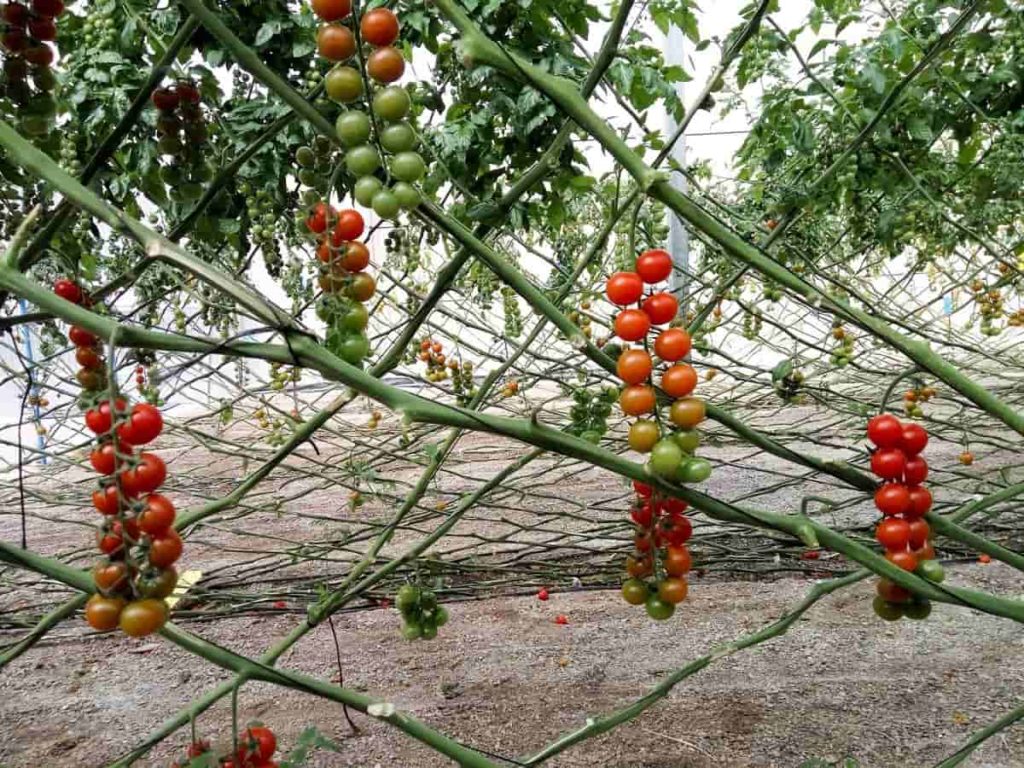
If you want to get high yields of delicious Tomatoes, you must provide the plants with the best care, proper pest control, and ideal conditions for growth. Let’s check out the top 24 steps to boost Tomato yield below.
Top 24 steps to boost Tomato yield
Step 1: Select high yielding varieties of Tomatoes
High-yielding Tomato varieties are Carmello, Big Beef, Celebrity, Stupice, Mountain Merit, Black Krim, Sungold, Sakura, Pozzano, and Jaune Flamme. Arka Rakshak is a high-yielding and disease-resistant variety developed by IIHR in Bangalore. Other high-yielding Tomato varieties are Cherry Tomato, Grape Tomato, Beefsteak Tomato, Roma Tomato, Aunt Ruby’s, German Green Tomato, San Marzano, etc.
Step 2: Prepare the soil well
The critical step in high-yielding Tomatoes is to prepare the soil properly before planting. Tomatoes love rich, well-drained, deep soil and thrive. This soil preparation allows the roots to grow deeper and access all the plant’s nutrients to grow. Test the soil before preparing it. Soil tests tell you what nutrients are lacking in your garden beds.
It also tells you the pH range of your soil, which is essential for Tomato plants. Ideally, the soil should be at least 12 to 24 inches deep, allowing room for the roots to spread. Finally, add fertilizer to your garden beds. Compost provides your plants with most of the nutrients they need to grow; assuming it’s a high-quality fertilizer, choose a place for your Tomato plants.
Step 3: Sunlight to get more plant growth
Tomato plants like full sun. It means 8 hours or more of direct sunlight daily.
Step 4: Purchase quality seedlings
If you buy seedlings, make sure they come from a standard source. Your local nursery greenhouse will supply the most popular varieties of Tomatoes that grow well in your area. Find small, strong Tomato plants that are healthy. Smaller plants are more easily grafted than larger plants. Aim for plants about 4-8 inches tall with strong stems and healthy plants.
Check the leaves for pests and diseases. Healthy plants will be equally green. Avoid plants whose leaves are yellow, spotted, withered, or twisted. These plants are stressed and do not adapt well when transplanted.
In case you missed it: Tomato Farming In Karnataka, Areas, Seasons, Yield
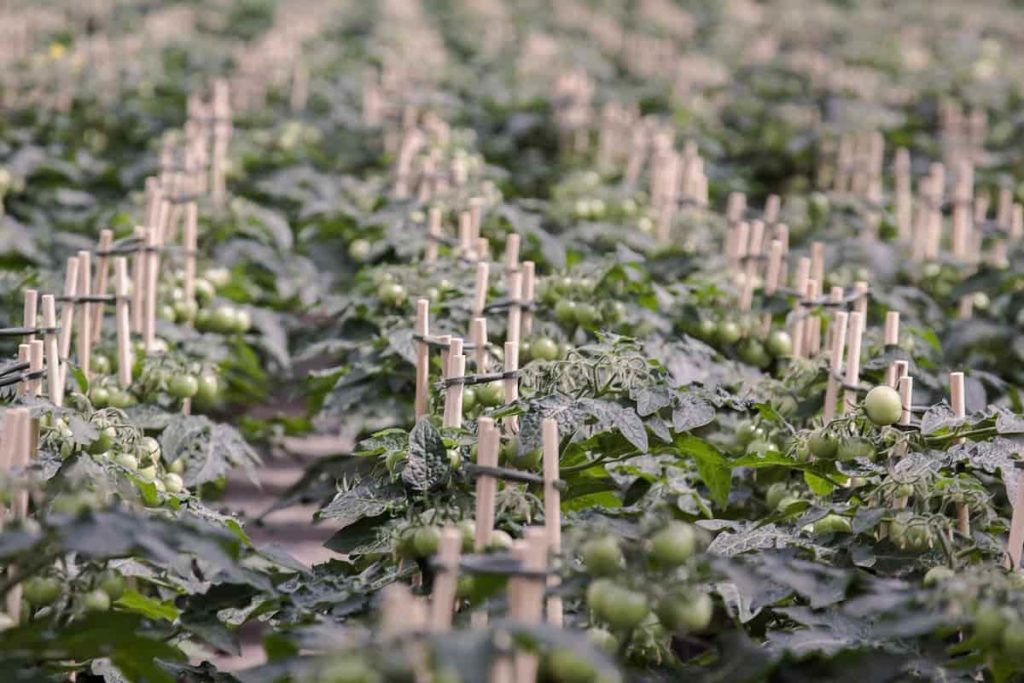
Step 5: Space your plants well
Depending on the type of Tomato plant, your plant’s need is very different. For example, indeterminate Tomato plants are larger than the determinate plants, so that they will need more space. Generally, a distance of two feet between plants is sufficient, but some species require a distance of up to three feet.
It is essential to keep your Tomato plants well-spaced to allow maximum airflow around your plants. It reduces the risk of fungal infections that thrive in hot, humid conditions. In addition, the airflow keeps your plant’s overall health, increasing your plant productivity.
Step 6: Fruit drop causes and solutions for more yield
Extreme temperatures, nutrient deficiencies, improper water, pests, or too much fruit can cause the Tomato plant to fall off. These factors can cause stress in the Tomato plant, which weakens the roots, stops the growth, and causes the Tomatoes to fall off the plant. Tomato fruit set and growth are greatly affected by overnight temperatures. When the plants are too shady or underwater, they may not bear fruit.
Also, check the fertilizer balance. Nitrogen promotes plant growth. Once the plants begin to flower and bear fruit, they need more phosphorus and potassium for the Tomatoes to be healthy and mature. Tomatoes sometimes fall off the plant before ripening, but this can be due to several reasons, including;
- Extreme temperature levels like too cold or too hot
- Improper watering (too much or too little)
- Nutrient Deficiencies
- Pests (They can put pressure on the plant or cause disease)
- Too much fruit (the plant can only help so many fruits to maturity)
You can keep Tomatoes drop from the vine by providing well-draining soil, adding nutrients, correct weather, and proper watering. Preparing well-drained soil, adding nitrogen-rich nutrients at the beginning of the growing season, and monthly low-nitrogen nutrient supplements will give your Tomato plants a good start. The next step is to water the right amount at the right time of the day and not allow the soil around the plants to become too dry or too saturated.
Step 7: Control flower drop in Tomato plants
When the flower stems turn yellow, and the flowers dry out, it is called a “blossom drop.” In Tomatoes, the main reason for this is the temperature that is either too cold or too hot. Tomatoes prefer a daytime temperature of 70 to 85°C. Follow good cultural watering practices and proper fertilization, and do not plant too early in the spring. If flower drop is a consistent problem in the summer season, try to provide some shade in the afternoon during the hottest periods.
In case you missed it: Mulching Tomato Plants, Procedure, and Benefits
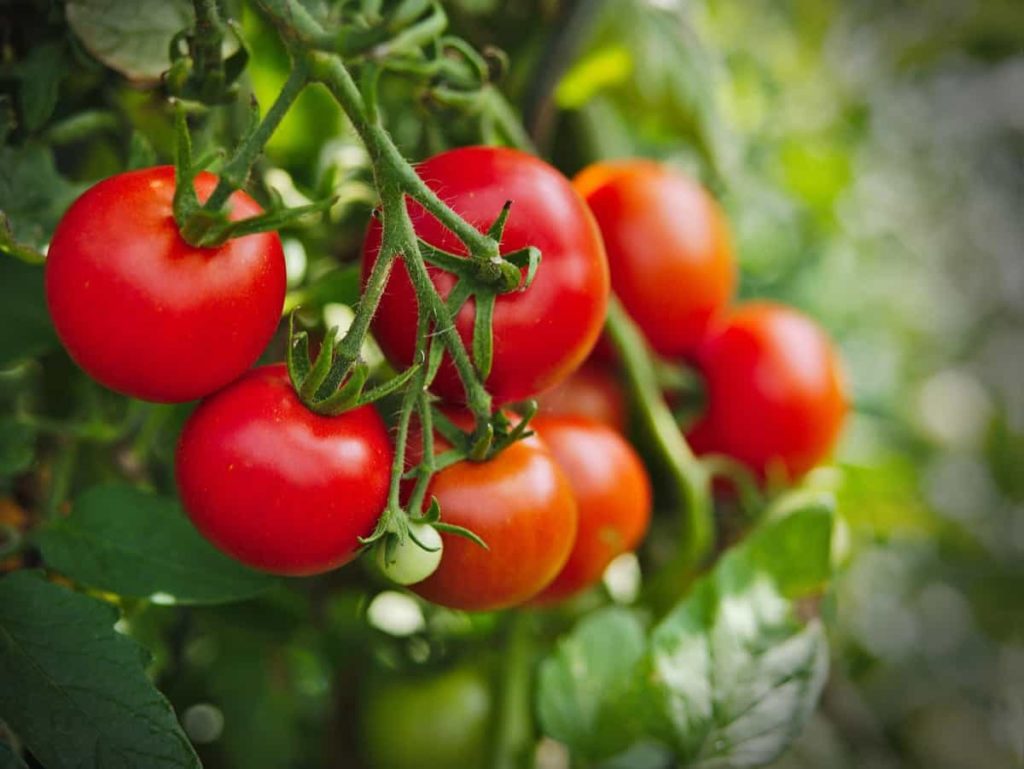
Controlling Tomato blossom drop
- Grow varieties suitable for your climate.
- Ensure pollination
- Suggested N rates used.
- Give deep water in dry weather.
- Control pests and diseases.
Step 8: The secret to increasing your Tomato yield
Feed properly – Tomatoes are heavy feeders. After all, they are producing a ton of fruit. Tomatoes need essential nutrients (nitrogen, phosphorus, and potassium) and secondary nutrients (calcium and magnesium), essential but small quantities. Balance is critical here, and it is essential to know when to apply fertilizer. It is recommended that you eat Tomatoes with a mixture that is low in nitrogen, medium in potassium, and low in phosphorus.
When planting, add a little fertilizer to the soil in the planting hole and grow the Tomatoes quickly so that the roots are easily accessible. When planting, include blood meal, bone meal, worm castings, and powdered eggshell. This compound provides a fast, water-soluble nitrogen source (blood meal). In addition, it ensures that phosphorus is present for strong roots (bone meal). Calcium comes from eggshells. Worm castings provide minimal nutrients but add beneficial microbes to the soil. These microbes help the plant get nutrients.
Step 9: Essential nutrients for Tomato plant growth
- Nitrogen provides fast-growing energy for foliage.
- Potassium helps in the development of sugar. It improves the skin’s skin color, color, longevity, and taste after harvesting. It also helps in resisting plant diseases.
- Phosphorus is essential for planting and developing a healthy root system.
- Calcium promotes the growth of your canopy, which helps to replenish your plant. It also reduces the chances of rot at the end of flowering.
- Magnesium helps the Tomato plant to flower and bear fruit.
Step 10: How do you give Tomato plants more fruit?
Firstly, choose indeterminate varieties of Tomatoes that will continue to bear fruit until the frost kills them. Secondly, mulch your Tomatoes to keep the soil warm and moist. Finally, use an electric toothbrush to polish your Tomatoes by hand and get more flowers to turn into fruit.
Step 11: Increase Tomato fruit set and weight
The crop’s balanced nutrition will help growers reach the Tomato fruit set and weight targets determined by market needs, Tomato type, and end-use of the fruit. Nitrogen form is essential in the Tomato crop. Maintaining a good balance between ammonium and nitrate forms is necessary for rapid growth and crop productivity. Boron plays a critical role in pollen germination and Tomato fruit set. Pre-flowering applications ensure a good fruit set and full yield potential.
In case you missed it: Growing Tomatoes Organically, Cultivation Practices
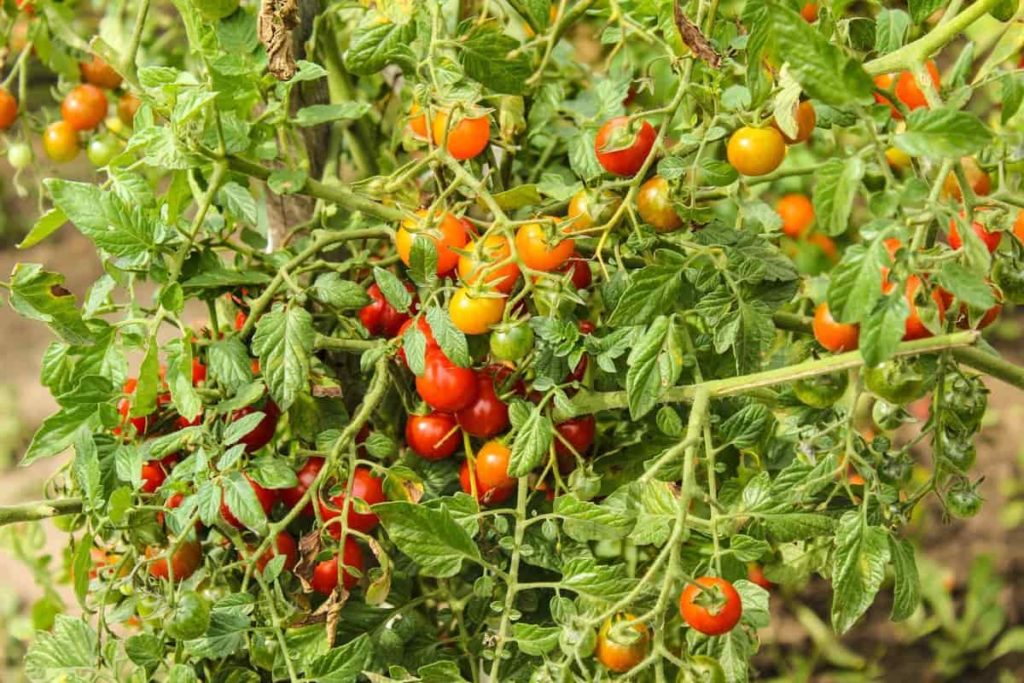
Step 12: Tips to fertilize to increase fruit size
Tomato plants usually need some extra nitrogen in the middle of the summer because the initial nitrogen reserves in the soil are depleted. The lower yellow leaves indicate the need for nitrogen. Nitrogen stress is currently a common cause of early blight. It is a good time to start regularly applying 24-8-16 water-soluble fertilizer for flowering plants or 18-18-21 formula for Tomato plants, as they provide the nutrients you need. Tomatoes are needed to produce large quantities.
Step 13: Causes of small Tomatoes
The most common cause of small Tomatoes is stressed plants. When plants are exposed to stressful circumstances, such as extreme drought or heat, pest infestation, or disease, they often stop sending their energy to flower or fruit production. As a result, flowers and fruits may stop growing and eventually leave the plant when pressed.
Drought or lack of water due to improper care is the first reason why Tomato fruits do not grow. The soil should be kept constantly moist, or the plants may show signs of stress such as wilting, leaf drop, or Tomatoes that are too small. Many gardeners grow Tomatoes in self-watering pots to ensure adequate soil moisture for fruit growth.
Step 14: Make sure you prune your Tomato plants
Tomato plants benefit from heavy pruning, resulting in larger and more productive crops. It starts by pinching off the lower branches. It happens when you remove the lowest branches to plant the stem deeply. It is also essential to pinch the Tomato flowers as your plant needs to put energy into the root development.
The next step is to remove all suckers from the leaf axils. Removing all suckers forces the plant to push all its energy into growth, flower, and fruit production. As your plant grows, remove the lower branches. If they are not bearing fruit, they need to be removed so that the plant can expend more energy in bearing fruit. It also prevents the leaves from touching the ground, leading to fungal and disease infections.
Step 15: Tomato branches curling
Your Tomato branches are curling because they can be exposed to environmental stress. For example, you may have given more water to the underwater or the soil. Sometimes malnutrition can also be a problem. Branches can also be curled due to pests and diseases.
Step 16: Tips for fast growth of your Tomato plants
The slow growth of your Tomato plants is usually due to water or soil problems. Make sure you do not keep your plants in or underwater. Check that your soil is well-drained and has a slightly acidic pH. And make sure you never freeze your Tomato plants as they can stunt or delay growth. Your Tomatoes will be small under adverse conditions, such as lack of water, high temperature, and lack of sunlight and pollination.
In case you missed it: Tomato Seed Germination, Time Period, and Procedure
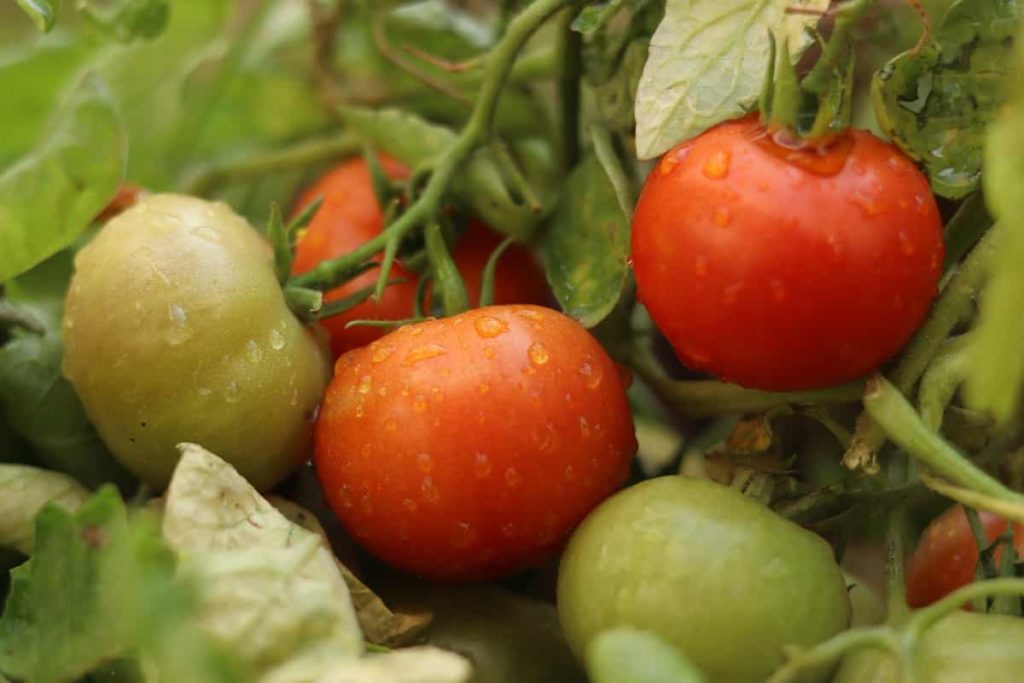
If your seeds or plants were labeled incorrectly, you might find smaller fruits than expected. The key to helping Tomato plants grow faster are nutrients and more nutrients. These plants need a constant supply of food during the growing season, so gardeners need to ensure that their garden beds have proper soil and timely application of fertilizers. Everyone thinks of macronutrients when it comes to planting growth.
Nitrogen, potassium, and phosphorus are the three major ones, but let’s not forget the importance of micronutrients. For example, tomato plants need a lot of micronutrients like magnesium if you want fast-growing plants. When plants suffer from magnesium deficiency, their growth stops because this nutrient helps plants absorb nitrogen and phosphorus properly.
Step 17: Install support for Tomato plants
You need to choose the correct support structure for plant growth. Vertical support lets your Tomato plants grow upwards rather than along the ground. It prevents diseases that can reduce your yield or destroy your crop. You can use Tomato stakes or a trellis to support long indeterminate varieties of Tomatoes. Use the twine to bind them every 12 inches (30 cm) or more as the plants grow. The Tomato cage works well to support shorter determinate Tomato varieties.
Step 18: Mulch to prevent weeds and produce more fruit
After transplanting your Tomato plants outside, you need to take steps to protect them. You can’t stop every pest and disease, but you can give your plants a better chance of survival. Mulch is a great way to help your Tomato plants flourish and produce more fruit. For one thing, mulch prevents your Tomato plants from growing and competing with them.
Mulch prevents weeds and keeps the soil moist, so your Tomatoes will grow better and produce more fruit. Mulch also insulates the soil to protect plants from unseasonal cold weather. Finally, a layer of mulch helps the soil retain water, making it easier to water your Tomato plants.
Step 19: Control the yellowing of the leaves in Tomato plants
Yellowing of the leaves is the most common sign of excess water. Unfortunately, the first reaction of a new gardener is to reach the hose and continue watering the plant, unaware that overwatering is more than likely the cause of the yellow leaves. The yellowing of the leaves is usually because the Tomato plant does not get enough oxygen; this can be either due to over-watering or loose soil, such as heavy soil, which can block water, and the plant roots can suffocate.
Step 20: Ways to speed up Tomato growth for a faster harvest
Maximize spacing between plants – Provide enough space for each Tomato plant to ensure adequate sunlight and airflow. Packed tightly, your plants are prone to excessive wetness, fungal or disease problems, and stunted growth.
Plant deep – Tomato plants do well when buried deep, especially when the weather is not right. You can bury three-quarters of each plant in each planting hole, removing the branches along the stem. A buried stem will grow new roots and anchor your plant better in the ground.
Provide plenty of support – Straighten and support your plant so that each branch receives as much sunlight as possible. It encourages early ripening.
Don’t apply organic mulch too early – Organic mulch has many benefits for the garden, but applying it too early can slow down the growth of your Tomatoes. Organic mulch, such as straw, newspaper, or cardboard, is known for its insulating properties and will keep the soil moist. If you are applying organic mulch, consider waiting until the summer heat is at its maximum.
Provide plenty of light – As well as loving the heat, this tropical plant grows faster with sunlight. Most Tomato varieties require at least 6 hours of sunlight daily, but more is always better. If you can, make sure your Tomatoes get at least 8 hours of sunlight daily.
In case you missed it: Hydroponic Tomato Farming, Nutrient Solution, Yield
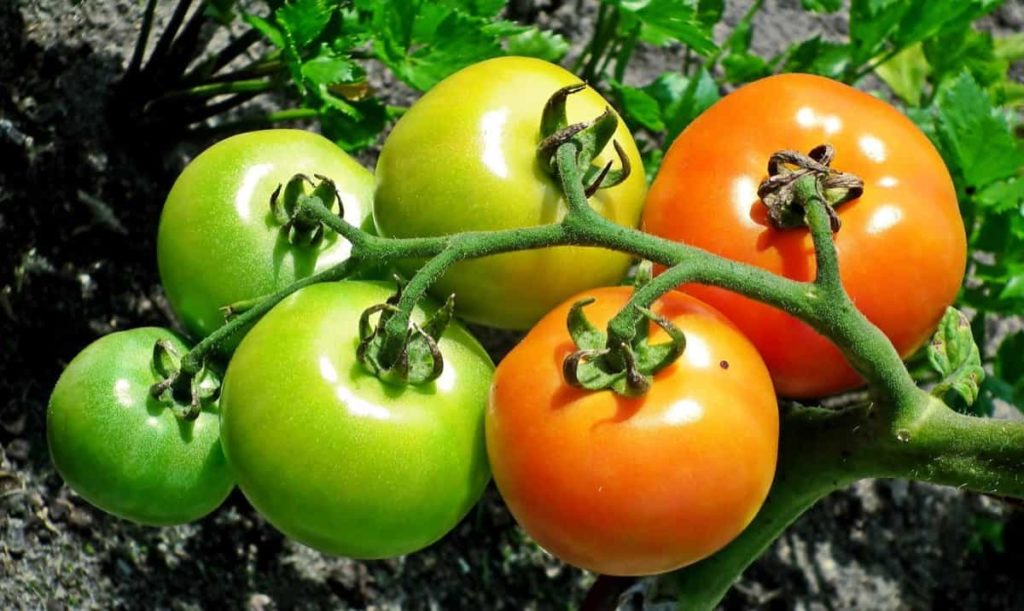
Step 21: Fruit cracks control for getting more yield
Ripe Tomatoes usually have cracks in concentric circles. Sometimes insects use cracked fruit as an opportunity to eat, or birds attack cracked fruit. What causes them: Hot, rainy weather causes fruit to break. After a long dry spell, the Tomatoes are thirsty. After the first heavy rain, the plants can take water quickly, making them bloom and crack.
What to do about them: Although you can’t control the rain, you can water the Tomatoes evenly during the growing season. It prevents them from being so thirsty that they pick up too much rainwater during heavy rains.
Step 22: Problems and their solutions for growing Tomatoes
Take a walk in your garden at least once a week and inspect your Tomato plants. Check the foliage, especially for spots and holes under the leaves. Look for fruit for damage, soft spots, or cracks. The most common pest you may encounter in Tomatoes is the Tomato hornworm. Hornworm insects are large green caterpillars that eat Tomato plants and fruits. Their droplets are more visible than insects.
When you see the grip, check the branches above, and you will probably see a hornworm. Please pick up the worms by hand and put them in a pot of soapy water. Tomato plants are susceptible to many bacterial, fungal, and viral diseases. Some are in the mud, waiting for things to get better. Some diseases come from the air or are transmitted to plants by insects. Diseases on the leaves appear as spots, blemishes, or yellowing of the leaves. Other diseases can cause sores on fruits or stems.
Tomatoes are susceptible to many diseases, which slow down if they do not kill the plant completely. Some of the diseases you can get on your Tomatoes are a blight, damping-off, and bacterial leaf spot. If you know your plants are getting sick, do online research by contacting the garden center to find out what you are dealing with and how to treat it. Then, prune off any diseased leaves or stems you may find.
Unfortunately, it may be necessary to eradicate the diseased plant. Many fungal problems will be kept away by keeping the growing environment dry by allowing good air circulation and light to penetrate. Again, keeping a distance between your plants and being careful with water will help keep your plants healthy.
Step 23: Protect your Tomatoes from birds
When you grow a beautiful crop of Tomatoes, you will attract some birds – especially if you plant red Tomatoes. However, you can reduce bird damage to your Tomato crop by choosing yellow, orange, and green varieties. You can also kill birds by pruning your fruit or protecting your plants from bird netting.
Step 24: Harvesting tips for getting more Tomatoes
Wait until the green Tomatoes show a few pink streaks if you are harvesting early. Cut the Tomatoes into clusters to keep them on the vine and place them in biscuits on your kitchen counter to continue ripening. Approximately, Tomatoes take 60 days to more than 100 days to harvest, depending on the plant variety.
Do not place them on a window in the sun or refrigerate them. Instead, please place them in a colander or basket on a cloth pad in indirect light. Rotate your ripe Tomatoes daily to prevent the development of soft spots. Rotation will allow air to circulate and will speed up the ripening process.
- How to Make Houseplants Bushy: Effective Tips and Ideas
- Innovative Strategies for Boosting Coconut Pollination and Yield
- Pollination Strategies for Maximum Pumpkin Yield
- The Complete Guide to Chicken Fattening: Strategies for Maximum Growth
- Natural Solutions for Tulip Problems: 100% Effective Remedies for Leaf and Bulb-Related Issues
- Revolutionizing Citrus Preservation: Towards a Healthier, Greener Future
- Natural Solutions for Peony Leaf and Flower Problems: 100% Effective Remedies
- Maximizing Profits with Avocado Contract Farming in India: A Comprehensive Guide
- Natural Solutions for Hydrangea Problems: 100% Effective Remedies for Leaf and Flowers
- The Ultimate Guide to Choosing the Perfect Foliage Friend: Bringing Life Indoors
- From Sunlight to Sustainability: 15 Ways to Use Solar Technology in Agriculture
- The Ultimate Guide to Dong Tao Chicken: Exploring from History to Raising
- The Eco-Friendly Makeover: How to Convert Your Unused Swimming Pool into a Fish Pond
- Mastering the Art of Delaware Chicken Farming: Essentials for Healthy Backyard Flocks
- 20 Best Homemade Fertilizers for Money Plant: DIY Recipes and Application Methods
- How to Craft a Comprehensive Free-Range Chicken Farming Business Plan
- Brighten Your Flock: Raising Easter Egger Chickens for Beauty and Bounty
- How to Optimize Your Poultry Egg Farm Business Plan with These Strategies
- Subsidy for Spirulina Cultivation: How Indian Government Schemes Encouraging Spirulina Farmers
- Ultimate Guide to Raising Dominique Chickens: Breeding, Feeding, Egg-Production, and Care
- Mastering the Art of Raising Jersey Giant Chickens: Care, Feeding, and More
- Ultimate Guide to Raising Legbar Chickens: Breeding, Farming Practices, Diet, Egg-Production
- How to Raise Welsummer Chickens: A Comprehensive Guide for Beginners
- How to Protect Indoor Plants in Winter: A Comprehensive Guide
- Ultimate Guide to Grow Bag Gardening: Tips, Tricks, and Planting Ideas for Urban Gardeners
- Guide to Lotus Cultivation: How to Propagate, Plant, Grow, Care, Cost, and Profit
- Agriculture Drone Subsidy Scheme: Government Kisan Subsidy, License, and How to Apply Online
- Ultimate Guide to Raising Araucana Chickens: Breed Profile, Farming Economics, Diet, and Care
- Bringing Hydroponics to Classroom: Importance, Benefits of Learning for School Students
- Ultimate Guide to Raising Polish Chickens: Breed Profile, Farming Economics, Diet, and Care
- Ultimate Guide to Raising Australorp Chickens: Profile, Farming Economics, Egg Production, Diet, and Care
- Silkie Chicken Farming: Raising Practices, Varieties, Egg Production, Diet, and Care
- Sussex Chicken Farming: Raising Practices, Varieties, Egg Production, Diet and Care
- Homemade Feed Formulations for Livestock: Discover Cost-effective Starter to Finisher Feed Recipes
- 20 Best Pig Weight Gain Supplements: Top Swine Weight Gain Formulas
- Ultimate Guide to Elderberry Farming: Propagation, Planting, Yield, Cost, and Profit